If you landed on this page, then you are definitely the one who cares about your flexibility and wants to know how flexible you are. Today, through this article, you will get your problem solved & as you get along the post, you will know how you can test your flexibility even at home.
FIRST OF ALL, LET’S HAVE A LOOK AT ‘WHAT IS A FLEXIBILITY TEST?’
Flexibility is the ability of a joint to move through its full range of motion (ROM), & it is important not just for gymnastics & yoga but also for making everyday movements easier, especially with age. Stiffness can cause older people to assume unnatural body positions, which can lead to back, neck, or shoulder pain. It’s especially important to pay attention to flexibility when you’re doing strength training. Tiny tears from weight training reappear stronger in muscles as those muscles get stronger. That makes the muscle tighter & starts to decrease the ROM throughout the joint.
Flexibility tests assess the ability of muscles & joints to move through their ROM with ease.
Because the flexibility of one joint does not affect the flexibility of other joints, we cannot determine flexibility with a single test..
1) SIT-AND-REACH TEST
This test is used to help assess your spine/back flexibility.
Precautions:
- Warm up.
- Stop the test if pain occurs.
- Do not be competitive.
- Do not perform fast, jerky movements.
- If any of the following apply, seek medical advice before performing tests:
- If you are presently suffering from acute back pain.
- You are currently recieving treatment for back pain.
- You have had a surgical operation on your back.
- A health-care professional told you to never exercise your back.
Test procedure:
- Sit on the floor with your legs straight, knees together, & toes pointing upward towards the ceiling.
- Place one hand over the other.
- The tips of your two middle fingers should be on top of each other.
- Slowly stretch forward without bouncing or jerking.
- Stop when tightness or discomfort occurs in the back or legs.
- Repeat this test two or more times & record scores as follows:
- First attempt : _______ points
- Second attempt : _______ points
- Third attempt : _______ points
- Total points = ________ divided by 3 = _______ points, which is rated as _______
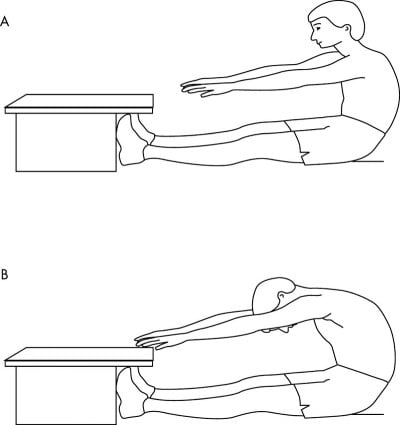
How to score (average of 3 attempts)
Reached well past toes = 1 point; excellent
Reached just to toes = 2 points; good
Up to 4 inches from toes = 3 points; fair
More than 4 inches from toes= 4 points; poor
2) SHOULDER FLEXIBILITY TEST
Precautions:
- Briefly warm up with a few minutes of stretching.
- Avoid rapid or jerky movements during the test.
Procedure for shoulder flexibility test:
- Bring the right hand around to the back of the neck.
- Bring the left hand around to the small of the back.
- Try to touch the fingertips of both hands behind the back.
- Have someone measure the distance between the fingertips.
- Do the test the other way, left hand to the back of the nack, right hand to the small of the back.
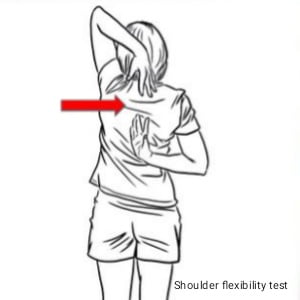
How to score:
Can clasp hands together = very good flexibility
Fingertips almost touch = good but need work
Not within an inch of touching fingertips together = poor, needs a lot of work
3) THIGH (FRONT) FLEXIBILTY TEST
Precaution:
Do not perform if you had knee problems or knee surgery.
Procedure for thigh flexibility test:
- Lie on stomach with one leg straight & bend another knee so heel moves toward buttocks.
- Test both legs.
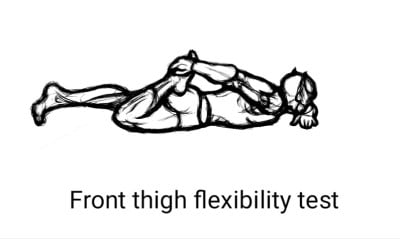
How to score:
Heel easily touches buttocks = good flexibility
The heel comes close but does not touch buttocks = flexibility needs work
The heel does not come within 6 inches of touching the buttocks = needs a lot of work
4) CALF FLEXIBILTY TEST
Procedure for calf flexibility test:
- Sit on the floor with legs straight & feet flat against a wall.
- While keeping heels against the wall, point toes & feet away from the wall, back toward the head, as far as possible.
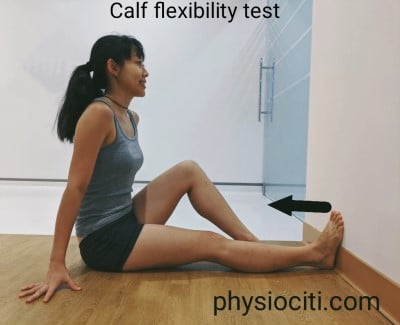
How to score:
Soles of feet move more than 4 inches from the wall = good flexibility
The soles of feet move several inches from the wall = flexibility needs work
Soles of feet barely move from the wall = flexibility needs a lot of work
5) HAMSTRING FLEXIBILTY TEST
Procedure for hamstrings flexibility test:
- Sit with one leg straight, one leg bent.
- Put the sole of the foot next to the knee of the straight leg.
- Gently curl upper body toward knee of the straight leg.
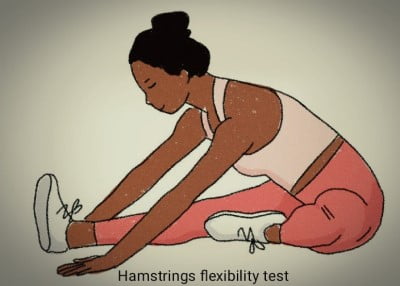
How to score:
Able to touch straight leg with upper body = good
Can move more than half the distance toward straight leg = good but need work
Able to move a few inches toward straight leg = needs a lot of work
6) GROIN FLEXIBILITY TEST
Test procedure for groin flexibility test:
- Sit on the floor with knees bent & heels of feet together 6 inches from buttocks.
- Push knees toward floor as far as possible with elbows.
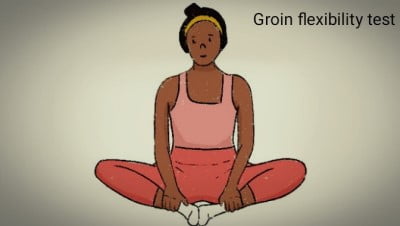
How to score:
Knees or calf muscles able to touch floor = good
The knees able to move about half the distance toward the floor = good but need work
Knees able to move only a few inches toward the floor = needs a lot of work
7) HIP FLEXORS FLEXIBILITY TEST
Procedure for hip flexors flexibility test:
- Lie on back with knees bent.
- Bring right leg toward chest by holdung knee with both hands.
- Hold it there tightly.
- Gently straighten left leg out to the floor, but do not let right leg move away from chest.
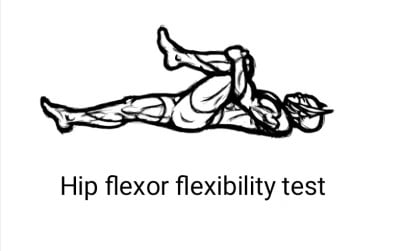
How to score:
Able to hold one leg firmly against the chest with another leg flat against the floor = good
Able to hold one leg against the chest while another knee is bent 2 to 4 inches off the floor = flexibility needs work
Unable to get one leg firmly against chest without causing pain or discomfort & other leg raises off the floor 4 or more inches = flexibility needs a lot of work
Once you performed all the tests mentioned above, you will have an idea about your flexibility level. So, if you found you are flexible enough then it’s very good but if you are unable to perform most of the above-mentioned tests then there is no need to worry. If one truly wants to, everything in this world can be made better. Let me help you with it.
Here, I have a stretching routine especially for you through which you can enhance your flexibility & make your daily living activities easier.
Thank you for reading this so far & if you really liked this article and found it helpful then please let me know in the comment section. You can also reach us at physiociti@gmail.com if you have any queries related to it.
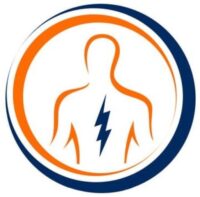
I want to thank you for your assistance and this post. It’s been great.